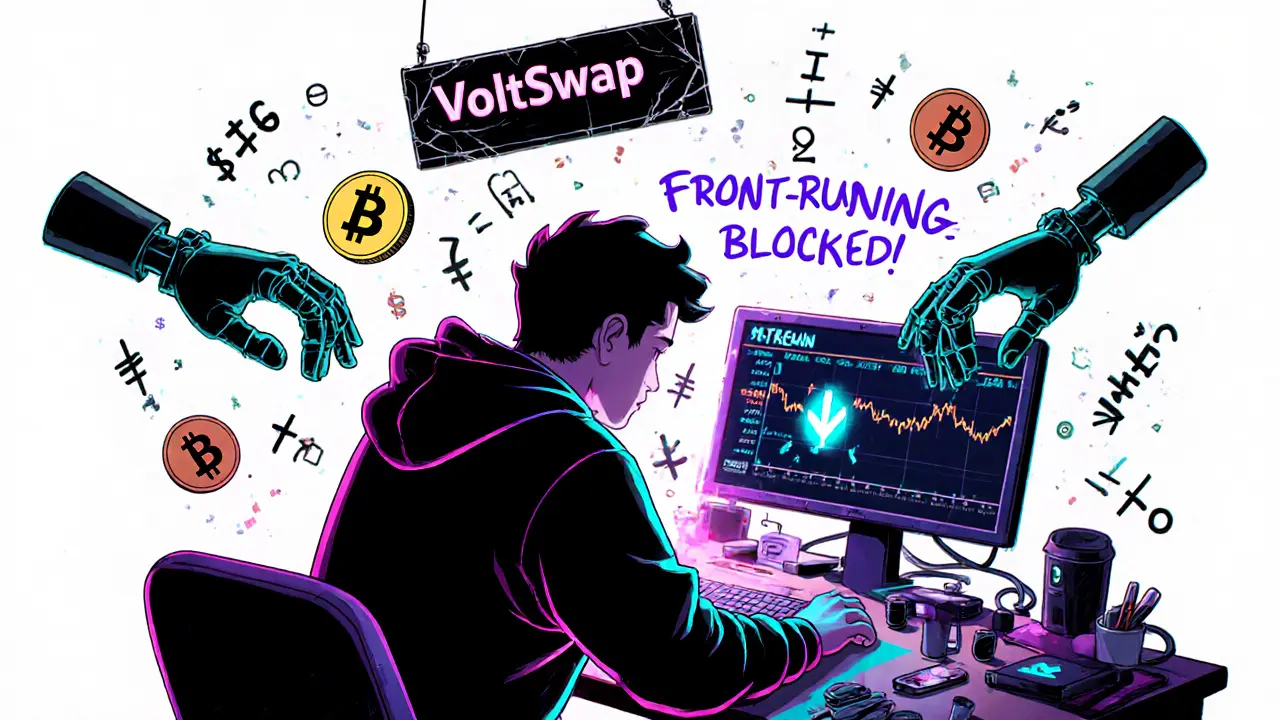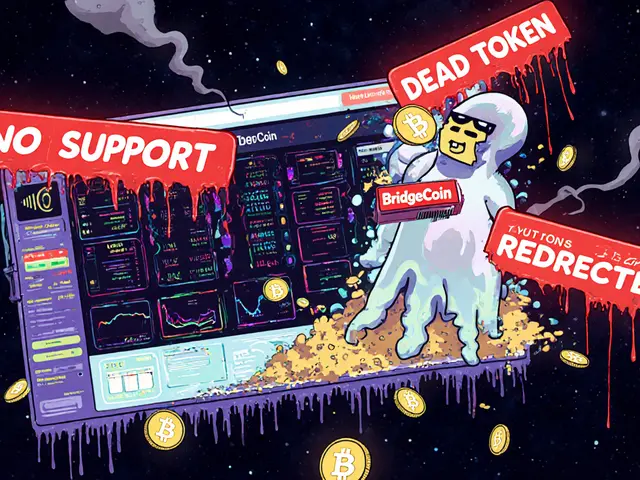VOLT Staking Earnings Calculator
VoltSwap distributes 50% of all trading fees to VOLT stakers. Your earnings depend on:
- Current daily trading volume ($6.02 as of October 2025)
- Current VOLT token price ($0.00022 as of October 2025)
- Your staked VOLT amount
Your Estimated Staking Earnings
Daily Earnings
$0.00
Weekly Earnings
$0.00
Monthly Earnings
$0.00
How This Works
VoltSwap distributes 50% of trading fees to VOLT stakers. Based on current volume of $6.02 per day, the total daily fees are approximately $0.30 (5% of volume). Since 50% goes to stakers, your potential daily earnings are $0.15.
Example: If you stake 1,000 VOLT tokens and the price is $0.00022, your estimated daily earnings would be $0.00033 ($0.00000022 per token) or $0.00033 in USD.
Most people looking for a crypto exchange think of Binance, Coinbase, or Uniswap. But what if you’re tired of high fees, slow trades, or bots stealing your profits before you even click confirm? That’s where VoltSwap comes in - a decentralized exchange built on the Meter blockchain, promising front-running resistance and near-zero transaction costs. But here’s the truth: even with clever tech, VoltSwap is still fighting an uphill battle in 2025.
What Is VoltSwap, Really?
VoltSwap isn’t just another DEX. It’s the first cross-chain swap platform built entirely on the Meter blockchain, designed to fix one of DeFi’s biggest headaches: front-running. That’s when traders use bots to detect your pending trade and jump ahead of it to profit off your move. On most DEXs, this happens all the time. VoltSwap claims to block it completely using its Layer 2 architecture.
The platform runs on Meter’s fast, low-cost network, which means trades settle in seconds and cost pennies - not dollars. It’s not built for massive volume like Uniswap. Instead, it’s built for users who want control, speed, and fairness. The whole thing is governed by the VOLT token, which gives holders voting rights and a share of trading fees. No central company owns it. No CEO makes decisions alone. It’s all community-run.
How VoltSwap Works - No Fluff, Just the Mechanics
To use VoltSwap, you need three things: a Web3 wallet (like MetaMask or WalletConnect), some MTRG tokens (Meter’s native coin) for gas fees, and the ability to connect directly to the Meter blockchain. There’s no sign-up. No KYC. No email verification. You own your keys. That’s the DeFi promise.
Once connected, you can swap tokens directly on the platform. VoltSwap supports cross-chain trading via Meter Passport, meaning you can trade assets from Ethereum, BSC, or Polygon without wrapping or bridging manually. The system handles the conversion automatically behind the scenes. It’s smooth - if you’re already familiar with Uniswap.
The real standout feature? The NFT-based smart wallet for yield farming. Instead of traditional LP tokens, VoltSwap uses ERC721 NFTs to represent your farming position. This means you can track, transfer, or even sell your farming stake like a collectible. It’s a small detail, but it makes farming feel more personal and flexible.
The VOLT Token: Power, Profit, and Pitfalls
VOLT is the heartbeat of VoltSwap. With a max supply of 100 million tokens, about 53.87 million are already in circulation as of October 2025. That means nearly half the supply is still locked for future rewards.
Here’s how VOLT works:
- Governance: Holders vote on proposals - fee changes, new token listings, protocol upgrades.
- Revenue Share: 50% of all trading fees are distributed to VOLT stakers. You don’t need to provide liquidity. Just stake your VOLT and earn.
- Tokenomics: 90% of all VOLT tokens were allocated to farming rewards over four years. That’s a long incentive schedule - meant to lock in users.
But here’s the catch: VOLT’s price has crashed hard. It hit $0.2352 in January 2022. Today, it trades around $0.00022. That’s a 99.9% drop. The all-time low was $0.0001521 in April 2025. So yes, it’s up 58% from that low - but that’s like saying your car’s value went up from $500 to $800 after being stolen. The damage was already done.
Daily trading volume? Around $6. That’s not a typo. Six dollars. In a 24-hour period. The most traded pair is VOLT/MTRG - meaning almost all activity happens inside VoltSwap’s own ecosystem. No major exchanges list VOLT. That’s a red flag for liquidity.

Who Is VoltSwap For? (And Who Should Stay Away)
VoltSwap isn’t for everyone. Here’s who it actually fits:
- Meter blockchain believers: If you think Meter will grow, VoltSwap is your gateway. It’s the only major DEX on the network.
- Front-running victims: If you’ve lost money to bots on Uniswap or PancakeSwap, VoltSwap’s tech could be a relief.
- Long-term stakers: If you believe in VOLT’s revenue-sharing model and want passive income without LP risk, staking is worth testing.
Here’s who should avoid it:
- Traders needing liquidity: You won’t find big trades. Swapping $10,000 of ETH for USDT? Forget it. Slippage will kill you.
- New crypto users: No customer support. No help center. If you mess up your wallet, you’re on your own.
- Speculators chasing quick gains: VOLT is not a pump-and-dump coin. It’s a slow, community-driven project. Don’t buy it hoping for a 10x.
How VoltSwap Compares to Other DEXes
Let’s cut through the noise. Here’s how VoltSwap stacks up against the big names:
| Feature | VoltSwap | Uniswap (Ethereum) | PancakeSwap (BSC) | SushiSwap (Multi-chain) |
|---|---|---|---|---|
| Blockchain | Meter (Layer 2) | Ethereum | Binance Smart Chain | Multi-chain |
| Front-running resistance | Yes (claimed) | No | No | No |
| Avg. transaction fee | $0.01-$0.05 | $5-$20+ | $0.10-$0.50 | $1-$5 |
| 24h trading volume | $6.02 | $1.2B | $350M | $180M |
| Token revenue share | Yes (VOLT stakers) | No | No | Yes (SUSHI stakers) |
| Yield farming format | ERC721 NFTs | LP tokens | LP tokens | LP tokens |
| Supported chains | Primarily Meter | Ethereum | BSC | 15+ chains |
Look at that volume difference. VoltSwap isn’t competing on scale. It’s competing on philosophy. It’s saying: “We don’t need 100 million users. We need 10,000 who care about fairness.” That’s noble. But is it enough?

Is VoltSwap Safe? Taxes, Risks, and Realities
Technically, yes - VoltSwap is safe because it’s decentralized. Your funds never leave your wallet. No one can freeze your account. No one can shut it down.
But safety isn’t just about code. It’s about survival. VoltSwap has no marketing team. No venture funding. No big-name investors backing it. It survives on community effort. That’s rare - and risky.
And don’t forget taxes. Every trade you make on VoltSwap is taxable. The IRS and other agencies track blockchain transactions. You’re responsible for reporting gains or losses. No platform will do it for you.
Also, if Meter blockchain adoption doesn’t grow, VoltSwap will fade. It’s tied to one chain. If Meter loses developers or users, VoltSwap goes with it. That’s the biggest risk.
The Verdict: A Quiet Experiment With Big Ideas
VoltSwap isn’t a crypto unicorn. It’s not going to make you rich overnight. But it’s one of the few DEXes actually trying to solve real problems - not just copy-pasting Uniswap’s model.
If you’re a DeFi purist who hates front-running, loves low fees, and believes in community ownership, VoltSwap deserves a small test. Put in $20. Stake some VOLT. Try a swap. See how it feels.
But if you want volume, liquidity, or a chance at quick profits? Walk away. There are better places for that.
VoltSwap is a quiet rebellion. It’s not loud. It’s not flashy. But for some, that’s exactly what they’ve been looking for.
Is VoltSwap a scam?
No, VoltSwap is not a scam. The code is open-source, the team is anonymous but active in community forums, and the platform has been running since 2021 without any rug pulls or exit scams. However, its extremely low trading volume and token price decline mean it’s a high-risk, low-liquidity project. Treat it like a niche experiment, not an investment.
Can I earn passive income with VOLT?
Yes. By staking VOLT tokens, you earn 50% of all trading fees generated on VoltSwap. You don’t need to provide liquidity or lock up other assets. Just hold and stake VOLT. The returns are small right now due to low volume, but the mechanism is real. If trading picks up, your earnings could rise.
Do I need MTRG to use VoltSwap?
Yes. MTRG is the native gas token of the Meter blockchain. You need MTRG to pay for transaction fees when swapping tokens or staking VOLT. You can buy MTRG on exchanges like Gate.io or PancakeSwap, or swap other tokens for it directly on VoltSwap if you have enough liquidity.
Is VoltSwap available on mobile?
VoltSwap doesn’t have a dedicated mobile app. But you can access it through any Web3 wallet app that supports the Meter blockchain - like MetaMask, Trust Wallet, or WalletConnect. Just open the VoltSwap website in your phone’s browser and connect your wallet. It works fine on mobile.
Why is VOLT’s price so low?
VOLT’s price crashed because of low demand and lack of adoption. After its initial hype in 2021-2022, the Meter blockchain failed to attract large-scale users or institutional interest. Without volume, the token lost its speculative appeal. The current price reflects market sentiment, not the project’s technical merit. It’s a classic case of innovation outpacing adoption.
Can I trade VOLT on Binance or Coinbase?
No. VOLT is not listed on any major centralized exchanges like Binance, Coinbase, or Kraken. The only place to trade it is on VoltSwap itself, using the VOLT/MTRG pair. This limits accessibility and liquidity, making it harder to buy or sell large amounts.
What happens if the Meter blockchain shuts down?
If the Meter blockchain stops operating, VoltSwap will cease to function. All tokens, staking positions, and farming rewards tied to the platform would become inaccessible. This is the core risk of any project built on a single, small blockchain. VoltSwap’s survival depends entirely on Meter’s longevity.






Adrian Bailey
man i tried voltswap last month after reading this post and honestly? it’s like using a flip phone in 2025 🤷♂️ but the front-running thing? real. i lost $80 on uniswap last week to bots, then did a $20 swap on voltswap and it went through clean. no drama. the UI is clunky though, and i typoed my MTRG amount once and almost cried. lol